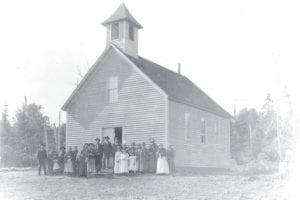St. Francis Xavier Church, built in 1895, is the most visible remnant of Chippewa City, once a thriving community separate from Grand Marais.
According to a brochure created by Staci Drouillard for the Cook County Historical Society, “The bulk of funds for the construction of the church was raised through basket socials. … Most of the contributions came from area lumberjacks, who were often far away from home and usually had plenty of money to spend.” The church was built of hand-hewn dovetailed timber by Ojibwe carpenter Frank Wishkop and includes a 225-pound bell.
When Europeans started settling in Grand Marais in the 1850s, many Ojibwe people already lived along the harbor’s edge and on the hillside. The population of Chippewa City was greatest between 1883 and 1898, with about 100 families living near the church. In the 1880s, Chippewa City even had its own sports team.
St. Francis Xavier was the only Catholic church in the area until 1916 when a second church was built in Grand Marais.
The population of Chippewa City fluctuated according to how much work was available in Grand Marais but eventually declined. Factors contributing to the decline include an expansion of Highway 61 in 1901 that cut through the community, a forest fire in 1907, an influenza epidemic in 1918, and loss of local employment due to the Depression in the 1930s. The last mass was held there on Christmas 1936, when only one or two families remained. The building was placed on the National Register of Historic Places in 1985 and was donated to the Cook County Historical Society by St. John’s Catholic Church and the Diocese of Duluth in 1998.
Through the years, restoration efforts have been sponsored by the Lions Club, the Minnesota Historical Society, and the Grand Portage Band of Chippewa.
According to local historian Alta McQuatters, the Chippewa City Church was saved by a bucket brigade during a forest fire around the turn of the century.
In his book Turning the Feather Around: My Life in Art (Minnesota Historical Society Press, 1998), the late artist George Morrison says of the church, which his grandfather James Morrison Sr. helped found, “The church remains a symbol of the community and our life there.”



Leave a Reply